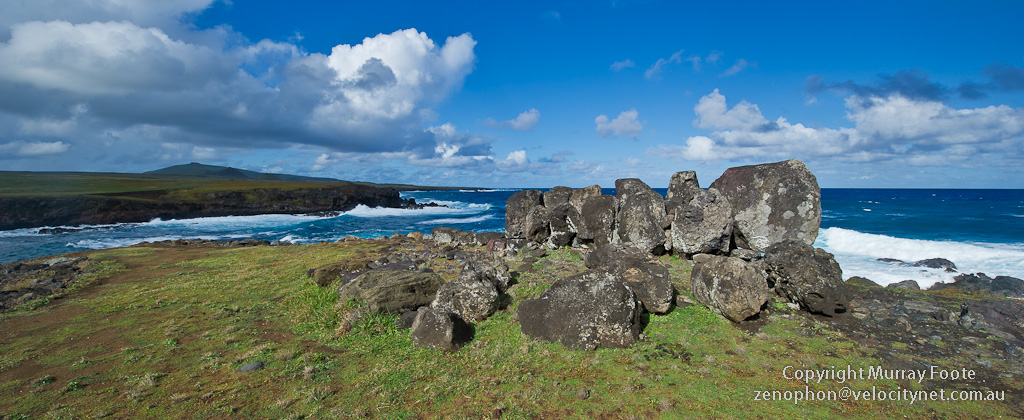We were due to leave Easter Island for Tahiti around noon but the plane was late, so we got a reprieve for half a day. We headed off towards the Eastern end of the South Coast and visited Ahu Runga Va’e and Ahu Hanga Te Tenga.
Google map location (green arrow).
Cook’s landing party would have walked past both these ahu on their walk back along the South Coast. They do not mention them although they do mention that another ahu has few moai standing (and this appears to be Akahanga). The moai on these ahu might have been toppled too, but since Cook’s party would have seen the ahu as they walked by, I think it more likely that the moai were still standing and that they considered this unremarkable. (For more on Cook’s visit, see the Hanga Piko post).
Ahu Runga Va’e is about 25 metres above the sea on a peninsula. Surprisingly, a large part of the cliff was artificial, built up from the bottom with large boulders, a stack that has resisted the sea and storms for many hundreds of years.
In the image above, the seaward wall of Ahu Runga Va’e is at the top left (where it’s dark). In the middle distance is a fallen moai. The pale buff rock directly in front is the natural cliff. After that, if you look carefully, you can see the way an artificial cliff is built up with large stones. It’s not obvious from this view but it’s about 80 feet (25 metres) high. You may need to click on the image for a much larger view to see this.

Another view past the side of the main ahu at Ahu Runga Va’e, with the sea and the coast, looking towards Ahu Hanga Te Tenga (which is out of sight)

Fallen moai at Ahu Runga Va’e. You can also see the red cylinder of a pukeo (topknot) in the distance.

View of the coast looking south-east from Ahu Runga Va’e. The headland in the far distance is part of the volcanic cone Rano Kau.
Ahu Hanga Te Tenga is quite large at roughly 80 metres long. It is just 500 metres further on from Ahu Runga Va’e though out of sight behind a headland. The Rapanui attempted to erect the largest moai ever placed on an ahu (at just under ten metres high) but unfortunately it fell over during the erection – so that honour stayed with Moai Paro at Ahu Te Pito Kura.
Click on the image above for a much larger view that you can zoom into and out of. (Then far lower right icon for full screen; and use mouse click, mouse wheel or icons to zoom in and out)
In the image above, the ahu and several moai are at mid-left. Another moai is fenced off further back towards the right. There are ten horses wandering around near that. There are two cars parked nearby. One is our rental car; the white one is from locals who are fishing nearby (an ancient pursuit). You can see them walking to their fishing spot on the rocks below their car. Directly behind the fenced-off moai is the small volcanic cone Maunga Toe Toe. To the left of that is the top of Rano Raraku. Behind that is Maunga Pua Katiki on the Poike Peninsula.
Google maps location (green arrow).
(Note that I have separated out Easter Island – A Parable for Our Times? from this page and the fifteen comments below relate to that post).





Pingback: Easter Island Wrapup and Contents | Murray Foote
I totally agree with this analysis. We have multiple problems in the modern world but overpopulation and the consequent destruction of resources overshadows the whole future of mankind. Murray, if you were the first person to propose this parallel in microcosm I take my metaphorical akubra off to you:).
LikeLike
Thanks very much, Richard. The immediate problem is to raise people’s awareness.
LikeLike
Pingback: textile reports
That was a Impressive item. I enjoyed it very much. Brice Aton
LikeLike
Thanks Brice
LikeLike
Great site here. So many websites like this cover subjects that can’t be found in magazines and newspapers. I don’t know how we got by 15 years ago with just print media.
LikeLike
Thanks very much.
LikeLike
Thank you for the comprehensive read; I have always dreamed of going there myself. The tale of Easter Island has always fascinated me as a real world example of dependence of culture on nature and its resources. It’s something I am interested in exploring later on in my blog too, so this is a great resource!
LikeLike
Thanks very much, Isaac
LikeLike
A very thought-provoking piece, Murray… much to think about and ponder on. You have argued the case so clearly, it baffles me why there are ever any arguments against your analysis… head in the sand mentality I guess. Thanks very much.
LikeLike
A lot of people just don’t want to know, I think.
When I finish my Hokkaido posts, in a week or two, I’m intending to separate out the Ahu Runga Va’e and Ahu Hanga Te Tenga images and text. I’ll make the Parable a separate post, creating or reworking some images to go with it and extend the conclusion with policy suggestions.
LikeLike
Good idea… I enjoyed it as it was but I think it makes sense to do as you intend.
LikeLike
Pingback: Easter Island: A Parable for Our Times? | Murray Foote
Pingback: Easter Island: A Parable for Our Times? | Murray Foote
Pingback: Itinerary of Journey to Patagonia, Antarctica and Easter Island | Murray Foote